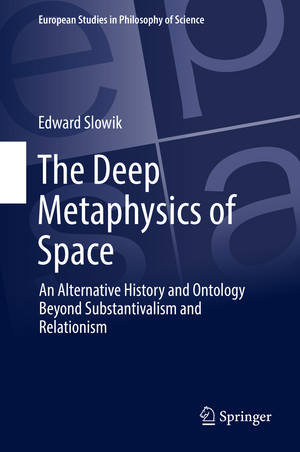The Deep Metaphysics of Space: An Alternative History and Ontology Beyond Substantivalism and Relationism: European Studies in Philosophy of Science, cartea 3
Autor Edward Slowiken Limba Engleză Hardback – 21 oct 2016
The author first discusses the two main opposing theories of the ontology of space. One, known as substantivalism, proposes space to be an entity that can exist independently of material things. The other, relationism, contends that space is a relation among material things. Readers will learn about specific problems with this dichotomy. First, Newton and Leibniz are often upheld as the retrospective forerunners of substantivalism and relationism. But, their work often contradicts the central tenets of these views. Second, these theories have proven problematic when transferred to a modern setting, especially with regards to general relativity and the recent quantum gravity hypotheses.
The author details an alternative set of concepts that address these problems. The author also develops a new classificational system that provides a more accurate taxonomy for the elements of all spatial ontologies. This classification obtains successful analogies between Newton, Leibniz, and other naturalphilosophers with contemporary physical theories.
| Toate formatele și edițiile | Preț | Express |
|---|---|---|
| Paperback (1) | 530.94 lei 6-8 săpt. | |
| Springer International Publishing – 28 iun 2018 | 530.94 lei 6-8 săpt. | |
| Hardback (1) | 706.63 lei 6-8 săpt. | |
| Springer International Publishing – 21 oct 2016 | 706.63 lei 6-8 săpt. |
Preț: 706.63 lei
Preț vechi: 831.33 lei
-15% Nou
Puncte Express: 1060
Preț estimativ în valută:
135.22€ • 141.36$ • 114.27£
135.22€ • 141.36$ • 114.27£
Carte tipărită la comandă
Livrare economică 07-21 martie
Preluare comenzi: 021 569.72.76
Specificații
ISBN-13: 9783319448671
ISBN-10: 3319448676
Pagini: 356
Ilustrații: XXIV, 342 p.
Dimensiuni: 155 x 235 x 21 mm
Greutate: 0.69 kg
Ediția:1st ed. 2016
Editura: Springer International Publishing
Colecția Springer
Seria European Studies in Philosophy of Science
Locul publicării:Cham, Switzerland
ISBN-10: 3319448676
Pagini: 356
Ilustrații: XXIV, 342 p.
Dimensiuni: 155 x 235 x 21 mm
Greutate: 0.69 kg
Ediția:1st ed. 2016
Editura: Springer International Publishing
Colecția Springer
Seria European Studies in Philosophy of Science
Locul publicării:Cham, Switzerland
Cuprins
Introduction.- Part I. Substantivalism and Relationism versus Newton and Leibniz.- A (Contrarian’s) Reappraisal of the History and Current State of the Ontology Debate in the Philosophy of Space.- Newton’s Neoplatonic Ontology of Space: Substantivalism or Third-Way?.- Leibniz’ Ontology of Space: Whither Relationism?.- Motion, Matter, Monads, and their “Forced” Relationship.- Part II. Third-Way Spatial Ontologies: Past and Present.- From Property to Structure: Exploring Contemporary Third-Way Conceptions of the Ontology of Space.- Newton’s Immobility Arguments and the Holism of Spatial Ontology.- The ‘Space’ at the Intersection of Physics, Metaphysics, and Mathematics.- The Multiple Paths towards an Epistemic Structural Realist Spatial Ontology.- Part III. The Deep Metaphysics of Space from the Seventeenth Century to Quantum Gravity.- A New Taxonomy Beyond Substantivalism and Relationism I: Early Modern Spatial Ontologies.- A New Taxonomy Beyond Substantivalism and Relationism II: SomePhilosophical Prehistory of Quantum Gravity.- Epilogue: The Post-Seventeenth Century Evolution of the Standard Dichotomy.- References.
Notă biografică
Edward Slowik is a Professor in the Department of Philosophy, Winona State University, Winona, MN, USA, and Resident Fellow at the Minnesota Center for Philosophy of Science. His research interests are in the philosophy of space and time, and Early Modern philosophy, with special emphasis on the ontology of theories of space and spacetime, both contemporary and in Early Modern period.
Textul de pe ultima copertă
This volume explores the inadequacies of the two standard conceptions of space or spacetime, substantivalism and relationism, and in the process, proposes a new historical interpretation of these physical theories. This book also examines and develops alternative ontological conceptions of space, and explores additional historical elements of seventeenth century theories and other metaphysical themes.
The author first discusses the two main opposing theories of the ontology of space. One, known as substantivalism, proposes space to be an entity that can exist independently of material things. The other, relationism, contends that space is a relation among material things. Readers will learn about specific problems with this dichotomy. First, Newton and Leibniz are often upheld as the retrospective forerunners of substantivalism and relationism. But, their work often contradicts the central tenets of these views. Second, these theories have proven problematic when transferred to a modern setting, especially with regards to general relativity and the recent quantum gravity hypotheses.
The author details an alternative set of concepts that address these problems. The author also develops a new classificational system that provides a more accurate taxonomy for the elements of all spatial ontologies. This classification obtains successful analogies between Newton, Leibniz, and other natural philosophers with contemporary physical theories.
The author first discusses the two main opposing theories of the ontology of space. One, known as substantivalism, proposes space to be an entity that can exist independently of material things. The other, relationism, contends that space is a relation among material things. Readers will learn about specific problems with this dichotomy. First, Newton and Leibniz are often upheld as the retrospective forerunners of substantivalism and relationism. But, their work often contradicts the central tenets of these views. Second, these theories have proven problematic when transferred to a modern setting, especially with regards to general relativity and the recent quantum gravity hypotheses.
The author details an alternative set of concepts that address these problems. The author also develops a new classificational system that provides a more accurate taxonomy for the elements of all spatial ontologies. This classification obtains successful analogies between Newton, Leibniz, and other natural philosophers with contemporary physical theories.
Caracteristici
Presents a new approach to the ontology of space Examines theories of space from the Early Modern period Analyzes the relationship between seventeenth century theories of space and current investigations in quantum gravity Includes supplementary material: sn.pub/extras


























